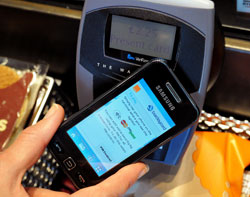The global near-field communications (NFC) retail payments market will reach $180bn (£116bn) by 2017, with one in four shoppers paying in store using the technology, according to a report from Juniper Research.
North America, western Europe and the Asia Pacific region will contribute 90% of this market value as smartphones with NFC payment technology become standard, said the research.

NFC will see a more than a seven-fold increase over 2012. Until recently the uptake of NFC has been limited to the east Asian market, which sees around $20bn dollars made via NFC payments every year.
The report found that 2011 was a watershed year for NFC payments as NFC-enabled smartphone models were announced by almost all handset manufacturers and Google ignited the market by launching its wallet in the US.
Major technology infrastructure standards were also finalised, mobile network operators announced moves to the market and payments were piloted.
The Post Office recently committed to the roll-out of NFC enabled devices, supporting contactless cards and mobile handsets.
Windsor Holden, co-author of the report said NFC payments would become increasingly important to retailers: "Mobile devices are a as hub between the physical and digital world. Retailers can use them as a marketing tool to drive customers to a physical location, gather information about them via NFC tags and push tokens to them when in store.
"It will be critical for retailers as a way of building brand relationship."
However, while the NFC spend figure for 2017 is substantial, it is still relatively small compared to e-commerce, which is worth $750bn globally per years; and even smaller compared with the $16tn total global retail transactions, he said.
If the mobile wallet is to see widespread uptake, operators will have to adopt an open system where various applications can be used across networks, rather than being locked down to a specific provider, he said.
"This is a critical time for the NFC retail payments market. Despite the significant progress being made today, the full potential of the market can only be fulfilled if all ecosystem players are equally committed and mobile wallet consortia remain in place," Holden said.
A lack of awareness about NFC might also hold the market back. For example, there are already around 20 million contactless cards in circulation in the UK, but most people do not use them, he said.
"Unless that percentage rises substantially it will take longer to see traction," Holden said.
Despite the predicted benefits to retailers, some companies remain sceptical and are unwilling to invest in contactless infrastructure so soon after the transition to chip and PIN, said Juniper.
Juniper arrived at the $180bn figure by tracking the Japanese NFC market, which is more mature, as well as looking analogous services which have up-scaled dramatically.




